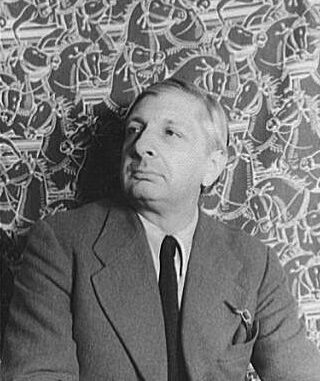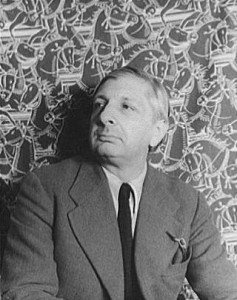

In his 1979 lecture on the writings of Giorgio de Chirico, the American poet John Ashbery recounts an anecdote involving a small group of the Italian artist’s fans who had sought the elderly painter at his home in an effort to reunite him with one of his early works. Whilst De Chirico welcomed his devotees, entertaining them with jokes and stories, he sent his wife – so the story goes – to call the police. The bewildered fans were arrested and the painting confiscated. Such was the old man’s disdain for the illusory cityscapes of his early work that had been embraced by the Surrealists in 1914.
The fans, perhaps during their more optimistic moments in custody, must have been tempted to console themselves with an interpretation of De Chirico’s actions as some grand Surrealist gesture, the kind of Dadaist joke Breton and Tzara would have been proud of. It is far more likely however that the painter’s eccentric behaviour was born purely from a cantankerous will to distance himself from the works of his pittura metafisica period, though it did not stop him from producing paintings he claimed were from that same era long into the early 1960s, such was their financial clout. In public at least, De Chirico had been condemning his early work as well as his modernist contemporaries since 1918 in favour of what he saw as a more refined return to the classicism of the High Renaissance.
Whatever De Chirico may have thought, the art of his metaphysical period has outlived his criticisms and pieces like The Uncertainty of the Poet (1913) and The Enigma of the Afternoon (both 1911) have become iconic works of early modernist painting. To think of De Chirico is to be confronted by the looming faces of his statues; the ominous presence of his frozen clocks; his assemblage of disparate objects and shapes. It is to find yourself standing in the shadows of an arch or in the silence of a seemingly dormant piazza, an oil black train and desolate hills in the distance of a somber green sky, twilight or dawn – it is never clear.
There is a sense of a trauma revisited in the early paintings; we return to the scene of some ordeal but from different, shifting perspectives, like an amnesiac trying to reconstruct the past from the fragments of recurring dreams. The paintings, especially those in the ‘Metaphysical Town Squares’ (1910) and ‘Piazza d’Italia’ (1913, though it has been argued they were painted much later) series imply moments suspended between presence and absence, actions about to happen and those that have passed irreconcilably.
In this oscillation between the metaphysical and the concrete we see his influence on filmmakers such as Antonioni and Tarkovsky whose long take-tracking shots in films like The Passenger (1975) and Stalker (1979) render their exploration of space and time with the same poetics that characterise De Chirico’s early work. Like Bosch and Breughel or Dalí who followed him, De Chirico’s pittura metafisica paintings present us with a world beholden to its own laws, where the quiet tension and eerie expanses of his landscapes operate at the boundary between the real and the ethereal. This is what must have appealed to the Surrealists – this transcendence of physical and temporal limits; its suggestion of atmospheres more present than tangible.
Perhaps it was the poetic nature of his early work that offended the older De Chirico, driving him so far as to have his own patrons thrown in jail. It can be interpreted as a crude revision of romanticism that any self-respecting resurgent classicist would be appalled by and which the Surrealists were constantly mocked for seeming to represent. Looking back on Surrealism though, from a vantage point almost equal to a century, the subtle transcendence of the real that De Chirico’s early paintings portray appear far more radical in our over-stimulated age of technological hyperactivity than the type of Surrealism that Dalí advocates with his bawdy assaults on sense and the senses.
The extremes and dominance of Dalí’s oeuvre have skewered our contemporary perception of the Surrealists and has arguably led to a commonly accepted branding of the movement as being weird-for-weird’s sake which seems banal at a time when pop megastars and their legions of fans happily fashion the bizarre. In this context it is hard to argue that works like the Aphrodisiac Telephone (1936), which is typical of Dalí’s brash use of juxtaposition, can offer anything more than a momentarily interesting image of a plastic lobster glued to a phone because we live in a time where we can, if we are so inclined, make a mobile phone call to London from an aquarium in Sydney whilst watching live lobsters in the fluorescent lights of their tanks.
The Surreal image now seems kitsch in contrast to our experience of modernity because the aesthetic and intellectual challenges they sought to provoke have been rendered anachronistic by the disorientation we take for granted. Even the simple, absentminded act of changing channels on a TV set with an endless variety of programs to choose from or standing on a street corner in a major city at rush hour will present you with a cascade of dissonant images far more disorientating than any form of pop-Surrealism if we only stop and reflect on the implications of what it is we are experiencing.
The Surrealists’ later critiques of capitalism and bourgeois culture were always implicit in their ideas – even before Breton started cozying up to Trotsky – and the legacy of their politics can be traced in the emergence of the Situationists. In this sense De Chirico’s haunting explorations of the urban landscape seems especially prone to Marxist critiques of modernity but despite what one thinks of that line of argument and however far they are willing to pursue it, it is worth noting that in the oneiric perspectives of his early work and the suggestion of its silences, De Chirico articulates a form of Surrealism that still seems genuinely arresting and subversive.
It is ironic that it is now De Chirico – the man who had his own fans thrown in jail – with his subtle and introspective paintings that presents more of a challenge to our experience of modernity than Dalí, an artist who actively sought celebrity and who strove to use his work to shock and offend at every opportunity. It would be interesting to measure the implications of this by asking a native of some kinetic metropolis like New York or Tokyo in fifty years perhaps, when the velocity of urban life in the early twenty-first century will seem as calm as time spent at a luxury health spa, which artist’s work seems stranger; Dalí or De Chirico’s? I don’t think it demands too much of the imagination to expect that the uncanny gravity of De Chirico’s cityscapes will grow as the reality they confront and transcend seems more like it has been designed by Dalí.


Leave a Reply